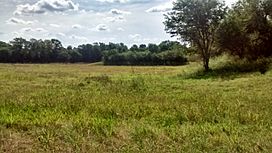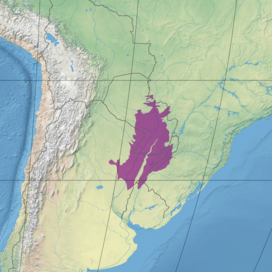Humid Chaco facts for kids
Quick facts for kids Humid Chaco |
|
|---|---|

Near Resistencia, Chaco, Northeastern Argentina
|
|
 |
|
| Ecology | |
| Realm | Neotropical |
| Biome | tropical and subtropical grasslands, savannas, and shrublands |
| Borders |
List
|
| Geography | |
| Area | 291,596 km2 (112,586 sq mi) |
| Countries | Paraguay, Argentina,, Brazil and Uruguay |
| Conservation | |
| Protected | 35,949 km² (12%) |
The Humid Chaco (also called Chaco Húmedo in Spanish) is a special natural area, or ecoregion, in South America. It has many different types of land, like grasslands, areas with scattered trees, and forests. This region is mostly found near the Paraná River in central Paraguay and northern Argentina. A small part also reaches into southwestern Brazil and northwestern Uruguay.
Contents
Exploring the Humid Chaco's Location
The Humid Chaco is located in the lowlands around the Paraná River and its smaller rivers, like the Paraguay River. To its west, you'll find the Dry Chaco, which is a drier area with different kinds of forests.
To the east, the Humid Chaco borders the Alto Paraná Atlantic forests. To the northeast, it meets the Cerrado grasslands. This ecoregion also touches large areas of flooded grasslands and savannas. These include the Paraná flooded savanna along the lower Paraná and Paraguay rivers, the Pantanal to the north, and the Southern Cone Mesopotamian savanna to the southeast.
The land in the Humid Chaco is mostly flat or gently sloping. The soil is mainly fine dirt and sand left behind by the rivers. Asuncion, which is the capital city of Paraguay, is located within this ecoregion.
Climate and Weather in the Humid Chaco
The Humid Chaco has a tropical climate. This means it's generally warm all year. As you move south, the climate becomes more subtropical.
The amount of rain changes across the region. The eastern parts get more rain, about 1,300 mm each year. The western parts, closer to the Dry Chaco, receive less, around 750 mm annually. Most of the rain falls during the summer months, from January to April. The driest time is in winter, from June to August.
Plants and Trees of the Humid Chaco
The Humid Chaco is a mix of different plant areas. You can find grasslands, savannas, forests, and even bogs. Grasslands and savannas usually grow on higher ground. Forests are found along streams and in areas that flood near rivers. Bogs are wet areas that form over soil that doesn't let water drain away.
The grasslands here have tall, rough grasses. You'll also see many palm savannas, which are open areas with palm trees like the Copernicia alba.
The forests are home to many types of trees. Some common ones are quebracho colorado (Schinopsis balansae) and quebracho blanco (Aspidosperma quebracho-blanco). Other trees include guayacán (Caesalpinia paraguariensis), espina corona (Gleditsia amorphoides), and urunday (Myracrodruon balansae). You might also spot viraró (Ruprechtia laxiflora), palo piedra (Diplokeleba floribunda), and guayaibí (Patagonula americana).
Amazing Animals of the Humid Chaco
The Humid Chaco is full of incredible wildlife. Many native mammals live here. You might see the powerful puma (Puma concolor) or the majestic jaguar (Panthera onca). The unique maned wolf (Chrysocyon brachyurus) also calls this place home.
Deer species like the red brocket (Mazama americana), gray brocket (Mazama gouazoubira), marsh deer (Blastocerus dichotomus), and pampas deer (Ozotoceros bezoarticus) roam the lands. Other interesting mammals include the White-lipped peccary (Tayassu pecari) and the collared peccary (Tayassu tajacu).
Look out for the giant anteater (Mymercophaga tridactyla) with its long snout. The capybara (Hydrochaerys hydrochaerys), the world's largest rodent, lives near the water. In the trees, you might hear the black howler monkey (Alouatta caraya) or see the Azara’s night monkey (Aotus azarae).
Many bird species also thrive here. The large greater rhea or ñandú (Rhea americana) can be seen in open areas. Other birds include the undulated tinamou (Crypturellus undulatus), the savanna hawk (Buteogallus meridionalis), and the colorful pale-crested woodpecker (Celeus lugubris).
Protected Areas in the Humid Chaco
A good portion of the Humid Chaco is protected. This helps keep its unique plants and animals safe. About 12% of the ecoregion, which is 35,949 square kilometers, is part of protected areas.
Some of these important protected places include Chaco National Park, Río Pilcomayo National Park, and Mburucuyá National Park in Argentina. In Paraguay, you'll find Ypoá National Park. The Iberá Wetlands, a large wetland area in the southeast, are also protected by Argentina's Iberá Provincial Reserve and Iberá National Park.
See also
 In Spanish: Ecorregión Chaco Húmedo para niños
In Spanish: Ecorregión Chaco Húmedo para niños

